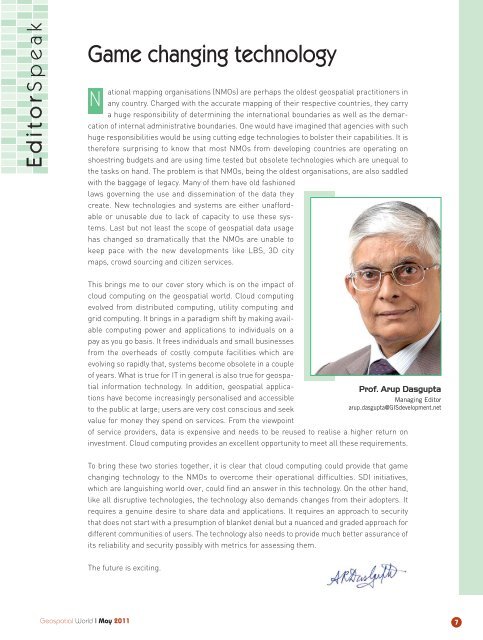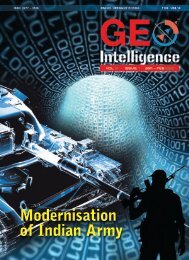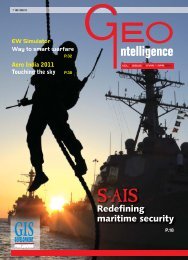Geospatial World Magazine - GeoSpatialWorld.net
Geospatial World Magazine - GeoSpatialWorld.net
Geospatial World Magazine - GeoSpatialWorld.net
You also want an ePaper? Increase the reach of your titles
YUMPU automatically turns print PDFs into web optimized ePapers that Google loves.
E d i t o r Speak<br />
ational mapping organisations (NMOs) are perhaps the oldest geospatial practitioners in<br />
any country. Charged with the accurate mapping of their respective countries, they carry<br />
a huge responsibility of determining the international boundaries as well as the demarcation<br />
of internal administrative boundaries. One would have imagined that agencies with such<br />
huge responsibilities would be using cutting edge technologies to bolster their capabilities. It is<br />
therefore surprising to know that most NMOs from developing countries are operating on<br />
shoestring budgets and are using time tested but obsolete technologies which are unequal to<br />
the tasks on hand. The problem is that NMOs, being the oldest organisations, are also saddled<br />
with the baggage of legacy. Many of them have old fashioned<br />
laws governing the use and dissemination of the data they<br />
create. New technologies and systems are either unaffordable<br />
or unusable due to lack of capacity to use these systems.<br />
Last but not least the scope of geospatial data usage<br />
has changed so dramatically that the NMOs are unable to<br />
keep pace with the new developments like LBS, 3D city<br />
maps, crowd sourcing and citizen services.<br />
This brings me to our cover story which is on the impact of<br />
cloud computing on the geospatial world. Cloud computing<br />
evolved from distributed computing, utility computing and<br />
grid computing. It brings in a paradigm shift by making available<br />
computing power and applications to individuals on a<br />
pay as you go basis. It frees individuals and small businesses<br />
from the overheads of costly compute facilities which are<br />
evolving so rapidly that, systems become obsolete in a couple<br />
of years. What is true for IT in general is also true for geospatial<br />
information technology. In addition, geospatial applica-<br />
Prof. Arup Dasgupta<br />
tions have become increasingly personalised and accessible<br />
Managing Editor<br />
to the public at large; users are very cost conscious and seek<br />
arup.dasgupta@GISdevelopment.<strong>net</strong><br />
value for money they spend on services. From the viewpoint<br />
of service providers, data is expensive and needs to be reused to realise a higher return on<br />
investment. Cloud computing provides an excellent opportunity to meet all these requirements.<br />
To bring these two stories together, it is clear that cloud computing could provide that game<br />
changing technology to the NMOs to overcome their operational difficulties. SDI initiatives,<br />
which are languishing world over, could find an answer in this technology. On the other hand,<br />
like all disruptive technologies, the technology also demands changes from their adopters. It<br />
requires a genuine desire to share data and applications. It requires an approach to security<br />
that does not start with a presumption of blanket denial but a nuanced and graded approach for<br />
different communities of users. The technology also needs to provide much better assurance of<br />
its reliability and security possibly with metrics for assessing them.<br />
The future is exciting.<br />
<strong>Geospatial</strong> <strong>World</strong> I May 2011<br />
Game changing technology<br />
N<br />
7





